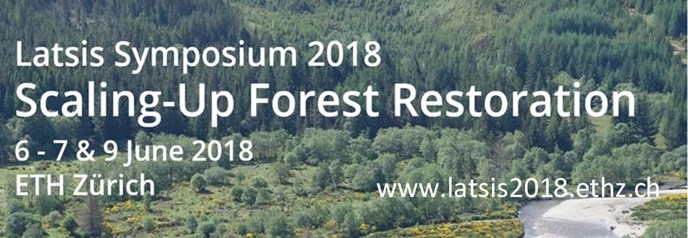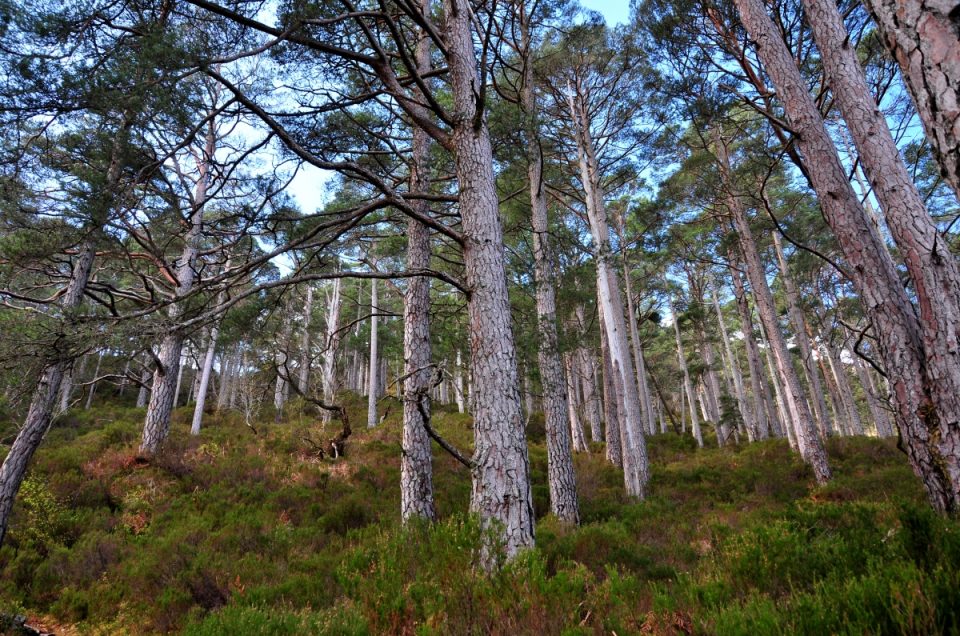By Jaboury Ghazoul, with contributions from Pedro Brancalion, Robin Chazdon, Thomas Crowther, Manuel Guariguata, Victoria Gutierrez, Stephanie Mansourian, Stewart Maginnis, Marc Metzger, Adrian Newton, Mike Perring, Sabine Reinecke, Mathew Williams, and Annelies Zoomers
This blog post is reposted with permission from the Latsis Symposium blog. For more information on the 2018 Latis Symposium (6-7 & 9 of June 2018 at ETH Zürich) see the bottom of this post and the Symposium website.
I wager that the most fundamental challenge humanity faces is how to ensure that the human-engineered socio-environmental landscapes that we brought into existence a mere 5000 years ago, can continue to co-exist with the natural world. If we are to sustain nine to ten billion people at a standard of living that we have come to expect while also maintaining a diverse and functional biosphere, then we need to gain a deep understanding of the underlying dynamics of our coupled socio-ecological systems. In other words, we need to understand how all our collective decisions shape the opportunities and constraints in social interactions and environmental spheres, and how, in turn, the resulting social and environmental outcomes influence our future options. A single-systems approach, one that is constrained within narrow disciplinary and scale boundaries, is comparatively easy, but hardly relevant to our current and future needs. Continuing to pursue such an approach in either science or policy risks squandering human, social, and financial capital when we can least afford to do so.
To continue to deliver agricultural productivity, provide credible climate change responses, maintain energy supplies, conserve biodiversity, and resolve social conflicts, we’ll need to ponder complexity. The pervasive inter-connectedness of biophysical, ecological, social, economic, and political systems across multiple scales demands complex adaptive systems thinking. A complex adaptive systems approach, one that transcends disciplines and scales, is difficult, but exactly relevant to our current and future needs.
Important features of systems thinking are scaling laws that apply across different spatial scales, as well as emergent properties of systems that might only be recognised at certain scales even though they result from processes and interactions operating at other scales. Addressing these aspects in isolation or at single scales risks failing to see the forest for the trees.
So what of forests? We are at the cusp of a global transformational process that has the potential to change societal perspectives and values relating to our environment. A global response to deforestation, land degradation, and climate change is encapsulated in the Bonn Challenge that seeks to restore 150 million hectares of deforested and degraded land to forest by 2020. Never mind that with only two years to go only about 5 million has yet been restored. More important is that this initiative has galvanised countries, organisations, and individuals to recognise the imperative need to reverse environmental degradation in all its forms.
Governments and organisations have already pledged over 160 million hectares for forest restoration, but pledges, while welcome, need to be translated into action. How?
How are we to scale-up from the existing restoration initiatives scattered around the world to a programme of restoration that is more than an order of magnitude larger than all our collective efforts to date? Any such challenge requires a systems thinking approach, and coordination and planning across policy, society, economic, and environmental sectors.
It is to this end that the Latsis Symposium 2018 on Scaling-Up Forest Restoration convenes in Zurich on 6 and 7 June.
The symposium is not about forest restoration per se, but rather about how we might overcome the challenges and leverage the opportunities to implement forest restoration at scales demanded by the Bonn Challenge, as well as the even more ambitious New York Declaration which extends the Bonn Challenge goal to bring 350 million hectares into restoration by 2030. What are these challenges and opportunities, and how should they be framed within systems thinking?
To answer these questions I have turned to some of the contributors to the Latsis Symposium to ask their views. Adrian Newton poses that we should begin by answering the question, Why scale up? There has to be a convincing reason to do so. At the moment we often lack the evidence that the benefits will outweigh the costs, particularly in relation to the broader impacts on the economy and on employment, rather than the immediate environmental benefits.
Marc Metzger warms to this theme by arguing that we need to start with an understanding of the different motivations behind contrasting visions of what forest landscape restoration (FLR) should look like. Different stakeholder groups in different geographic, social and cultural contexts might have quite different visions and expectations of restoration, or might not even agree with the basic premise that restoration is desirable. A first step is to negotiate acceptable visions across different interests, and then chart a roadmap towards an agreed vision that navigates the inevitable conflicts that will arise. Annelies Zoomers takes a similar line in expressing concern about how restoration might impact peoples’ livelihoods and access rights to land, forests, and resources. In our rush to embrace restoration, which is imbued with normative values that might not be universally shared, we risk trampling on other legitimate interests in headlong green land grabbing.
Sabine Reinecke similarly wonders whether there is sufficient political and cultural will for restoration, and how motivation for restoration can be scaled out across society given contradictory interests and world views. Forest and landscape restoration is very “political” and power loaded, and Sabine argues that existing socio-economic structures, power imbalances and inequalities will mostly determine how FLR is implemented, who benefits, and who is left out. The thoughts of Adrian, Marc, Annelies, and Sabine coalesce around the idea that successful scaling-up of forest and landscape restoration will require acknowledging and encompassing the many interests in FLR and integrating different stakeholder expectations in much fairer – and democratic – ways than we are used to, lest FLR becomes another arena for land conflicts. Sabine concludes with a call for new ways of thinking and engaging with stakeholders and society that might entail a move away from simple “majority democratic thinking” to a more inclusive and broadly representative reconsideration of how land-use is embedded in the organisation of our societies, economies, and financial systems.
Stephanie Mansourian emphasises that different interests and perceptions are reflected in a bewildering array of interpretations of what restoration is, what large-scale restoration is, and what forest landscape restoration is. Without a common and clear understanding it is difficult to measure restoration outcomes or aggregate efforts. Manuel Guariguata has a similar view regarding the need to harmonise terminology lest we run the risk of misusing the term “restoration” without due consideration of the multiple dimensions and complexity of the practice, particularly at landscape scales where trade-offs are inevitable during implementation.
While ambiguity can be constructive in facilitating dialogue across interest groups, there comes a point when misaligned interpretations can lead to tensions and undermine the restoration process. Sabine adds that there are continuing struggles over meaning in FLR, be it for strategic or paradigmatic reasons. People still broadly disagree about what FLR they actually want in practice and what they seek to achieve with it, as much as they disagree on who should actually benefit from the social, ecological and economic benefits deriving from FLR. Although we see much support for FLR as such, there is no agreement about the right means to get FLR into practice, from policy frameworks and rights/tenure systems, financial schemes, planning and management, as well as monitoring and safeguard approaches.
Mike Perring questions whether there is even enough land to meet ambitious restoration targets without compromising the livelihood and socio-economic objectives of rural communities, especially those that have long been disenfranchised. To this end, Robin Chazdon states that we have to make restorative land uses and interventions economically viable and attractive alternatives for farmers, landowners, and land managers as compared to many existing degradative or marginally productive land uses. Victoria Gutierrez wholeheartedly agrees with Robin and Mike, but adds that given the unique opportunity of mobilising extraordinary resources and capital to deliver on the Bonn Challenge targets, we must not lose sight of quality, which is ultimately the key measure of success. Robin and Victoria both call for agreed minimum criteria and guidelines for what constitutes ecologically and socially balanced restoration in landscapes, and support tools to enable and scale-up restoration to landscape scales and beyond.
It is clear from these perspectives that among the most important challenge is resolving the diverse expectations of multiple stakeholders and interest groups across scales. Manuel argues that at the heart of any solution must be participatory engagement and monitoring systems that connect local to national interests so that country-led aspirations and targets can be met while ensuring that social and environmental benefits accrue on the ground. Manuel recognises that a well designed participatory monitoring system will only generate good local decision-making and adaptive management actions if data collection is followed up with a program of communication and discussion to process and use such data.
Pedro Brancalion is excited by the very ambitious Bonn Challenge targets, but cautions that a sounder spatial strategy is needed that goes beyond simple maps that show areas “available” for restoration. He promotes the idea of a global plan that balances the different benefits and enabling conditions of restoration to identify areas where restoration investments should be prioritised and maximised. Indeed, as Tom Crowther notes, successful restoration in one place need not necessarily look the same as it does in other places. From an ecological perspective, we need to understand how the ecological status of forests varies across the globe in order to identify the appropriate restoration strategies in specific regions. This will also help us to understand how restoration in any region affects biodiversity, carbon storage and the climate, in addition to socioeconomic aspects.
A final challenge is securing the necessary financing for such large-scale initiatives in forest restoration. Mathew Williams highlights that a critical condition to access international funding to support restoration is effective monitoring, verification and reporting (MRV) of restoration interventions. Significant amounts of money have been promised to support restoration efforts, but the lack of MRV means these are not accessed, and so restoration cannot build and expand on repeated release of financial support.
The Latsis Symposium 2018 will explore all these issues, and how they can be integrated in a global strategy to restore forests and landscapes on substantial scales. Systems thinking, of which a flavour has been provided by our contributors, provides a framework by which we might respond to the current unique opportunity to materially and functionally improve landscapes and change social attitudes towards more sustainable philosophies.
—-
The Latsis Symposium 2018 brings together leading scientists and practitioners to address the ecological, economic, and societal challenges for scaling-up forest restoration. The symposium is motivated by the challenge of delivering an effective global response to two major environmental threats, climate change and forest degradation through restoration.
The goal of the 2-day symposium is to work towards a conceptual understanding of the challenges and opportunities for scaling-up forest restoration efforts to meet Bonn Challenge targets. Presentations by experts from academia, non-governmental organizations, and the business sector will help to frame and inform discussions on forest restoration approaches. Registration is free of charge and ends on 30 May 2018. For more details, please visit the symposium website.



